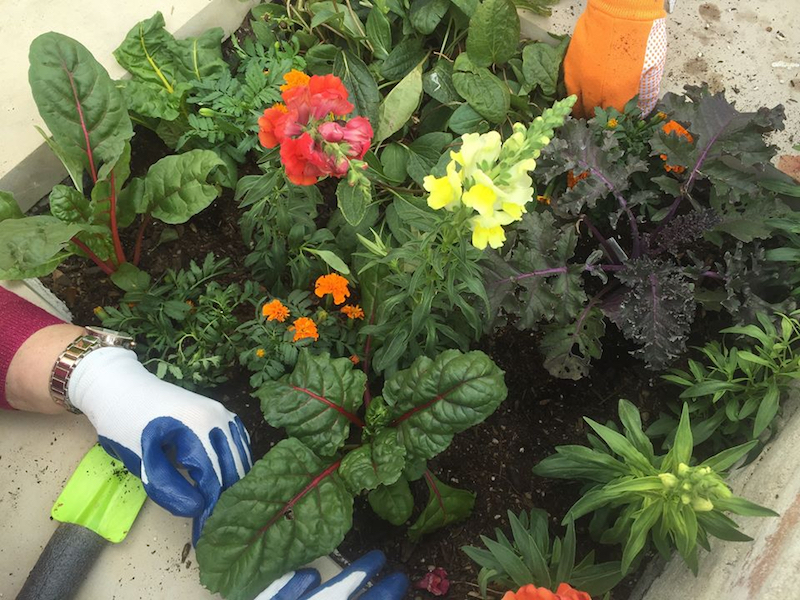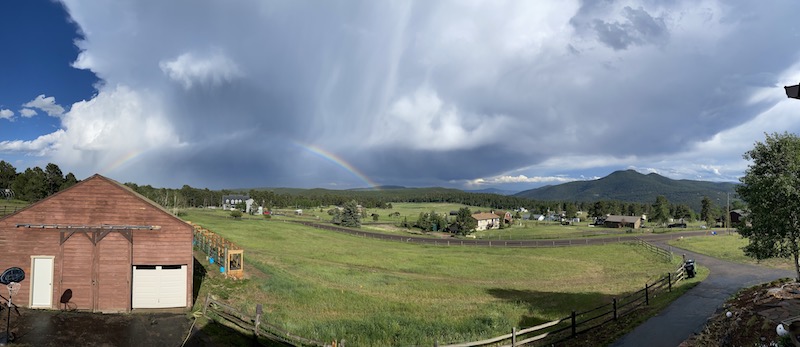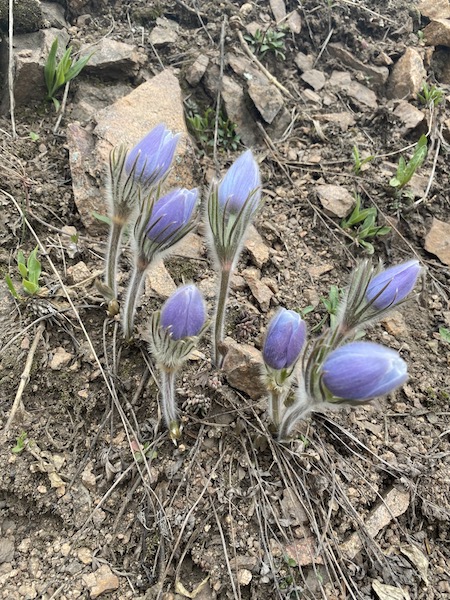by Perla Sofía Curbelo-Santiago
Meet my friend and colleague, Susan Morgan, from Denver, Colorado. We met after a virtual speaking engagement I had in early February, with Garden Comm´s members and allies.
My presentation was about how to use horticultural therapy values to produce content. Right after, I received a lovely email from Susan, commenting on how she enjoyed the webinar, and a couple of weeks later we Zoom. I found her personal story and work experience fascinated and I wanted you to get to know her too.
This year, to celebrate National Horticultural Therapy Week, I´m sharing Susan´s Q&A:

Susan Morgan, from Denver, Colorado.
Perla Sofía Curbelo- Santiago (PSC): How do you apply horticultural therapy core values to your life and work?
Susan Morgan (SM): My approach to providing therapeutic horticulture (TH) services to clients aligns with my approach to life: communicate with and treat others with respect and encouragement, while honoring their unique life experiences.
Using plants and nature in horticulture therapy/therapeutic horticulture helps participants to set aside negative ruminating thoughts and unhealthy behaviors, spark curiosity and creativity, and provide positive opportunities for discovery, growth, and connection.
(PSC): Can you elaborate more on how can Horticulture Therapy (HT)/Therapeutic Horticulture (TH) contribute to people’s lives?
(SM): When used in combination with other therapeutic processes and wellness activities, HT/TH activities can enhance people’s physical and mental health and wellbeing in many ways, but also improve overall outlook and mood.
When engaging with plants and nature activities, people find ways to connect with others and a bigger world outside of themselves.
In today’s times when we often feel overwhelmed and are connected, yet feel disconnected from each other in different ways, coming back to our roots through horticultural experiences (so to speak) can be incredibly grounding and bring us back to the basics.

Planting activity with a group. Photo: Susan Morgan
(PSC): What made you interested in the Horticulture Therapy topic?
(SM): As a horticulturist working at public gardens for several years, I recognized firsthand the benefits we gain when engaging with nature and was interested in using my skills to connect people with plants.
In my previous position at the Dallas Arboretum, I worked with several people who were resettled refugees from different countries in Africa and Asia and learned about challenges that refugees face when being displaced from their countries of origin and adjusting to life in the United States.
Inspired, I pursued training in horticultural therapy (HT) and learned about the various ways in which guided nature-based experiences can positively benefit resettled refugees and others facing various life challenges in the United States.
(PSC): What is your current work?
(SM): Professionally, I’ve been excited to reach my existing clients, as well as new ones, in unique ways through technology. Facilitating a floral arranging activity through Zoom is challenging, but totally worth it when a client sends me a picture of their beautiful arrangement with a proud smile on their face.
I’ve also been able to network with peers, like [you], Perla, around the world and attend informative webinars that I previously didn’t have the time to do.
Personally, I learned a lot about gardening at altitude last year and am going to take that knowledge to experiment with growing native and other favorite plants that will better tolerate the challenging conditions in the Rocky Mountains.
(PSC): Can you describe your region’s hardiness zone?
(SM): Technically, I live in USDA hardiness zone 5b. However, I live at 8500-feet elevation in a unique microclimate in the Rocky Mountains: dramatic temperature fluctuations year-round, cool summer nights, cold snowy winters, rocky alkaline soils, harsh sun angles, hail, high winds, dry climate, and low available groundwater.
Due to these environmental factors, I act as though I live in zone 3 and try to grow plants that tolerate cold temperatures and dry conditions. Plus, I have to contend with the local wildlife, which attacks my garden from all sides -deer, elk, and rabbits on top and pocket gophers and voles from underground.
After recently relocating from zone 8 in Texas, where I lived and gardened for several years, it was a huge adjustment to move here. It has been hard growing my favorite ornamental and edible plants at high altitudes – it’s doable but has proven to be quite challenging.

“Panoramic picture of our field/barn during a rainbow (you can see my 56-foot raised bed near the barn built to protect from pocket gophers, deer, and hail)”. Photo: Susan Morgan
(PSC): What are some of the common plants, flowers, or trees in your area?
(SM): I live in a small mountain town called Conifer, which is next door to towns called Evergreen and Pine. That is an appropriate description of many plants that live here: evergreen conifers like spruce and pine, but also deciduous aspen trees.
Unlike many of my neighbors who live in a coniferous forest, I live in an open mountain meadow, so in the spring and summer, I see a lot of beautiful wildflowers, such as shooting stars, irises, pasque flowers (Anemone pulsatilla), prairie Thermopsis (Thermopsis rhombifolia), and lupines (Lupinus).

Pasque flowers. Photo: Susan Morgan
(PSC): What garden-related activities you enjoy most and would recommend others?
(SM): At least try. Weeding can be a tedious task, and just getting started is often challenging. However, I have found that the process of weeding can be very therapeutic. During weeding, I find that I lose track of time, and two hours will pass by in what seems like 10 minutes.
Some of my best Aha! clarity moments come during my weeding sessions. I think it’s because my mind is allowed to wander, download, and process all the thoughts and emotions I’ve been experiencing while moving through my busy daily life.
I often feel recalibrated and physically better after weeding, find clarity on questions I have, and enjoy how my garden looks all cleaned up. All that being said, mulching or close plantings can help to suppress weeds from growing in the first place!
(PSC): If anyone would visit your state/city/town, which nature-related destinations would you recommend? And, why?
(SM): Colorado is rich with natural resources and beautiful scenic areas. It is truly a great place to experience nature. The Rocky Mountain National Park and Great Sand Dunes are amazing places to visit.
I also like visiting the Garden of the Gods in Colorado Springs. In my immediate area, I love hiking the trails in our local parks in the Jefferson County Open Space. I like to recommend favorite public gardens too, such as the Denver Botanic Gardens and its satellite campus in Chatfield as well as the Betty Ford Alpine Gardens in Vail.
(PSC): Any book, podcast, movie nature-related that you enjoyed and want to share with us?
(SM): I love listening to podcasts and audiobooks. One memorable podcast/YouTube video was a 2016 interview by time-lapse nature cinematographer Louie Schwartzberg on the beauty of slowing down, on entrepreneur Marie Forleo’s podcast.
I’m inspired by how he experiences the world – from the point of view of a flower – and cultivates a sense of wonder and awe, which are key elements of my TH program with clients.
(PSC): How can gardening change the world?
(SM): Gardening reminds us to slow down, tune into, and engage with our surroundings. Though there are many opportunities for instant gratification in gardening, the notion that good things come to those who wait is another big lesson that can be learned over and over again in the garden.
When someone is working to find self-acceptance or overcome a personal challenge, nature can help ground us in the present and teach these important lessons.
(PSC): What would you say is your superpower?
(SM): My journey as a horticulturist and therapeutic horticulture practitioner has helped to highlight some of my superpowers, including my listening skills and intuitive and empathic abilities to read and understand people and plants.
As a gardener, I have to intuitively read my plants’ signals about their needs because they can’t say “Hey Susan!” and tell me what they need.
This process gets incrementally better as I try to grow plants, fail/succeed, and adjust, without giving up. The same goes when working with people in my TH programs, including individuals with cognitive and/or social challenges where they may have difficulty communicating their needs.
I have to read client cues in order to encourage and help enable their engagement with the task at hand. I feel like I am better able to connect with people (and plants) by listening and paying attention to what their signals and body language are telling me.
Follow Susan on Instagram
Read her blog: https://eatbreathegarden.com/
Perla Sofía Curbelo-Santiago is the founder of Agrochic.com and is Certified in Horticulture Therapy (HTC) from Chicago Botanic Garden.

